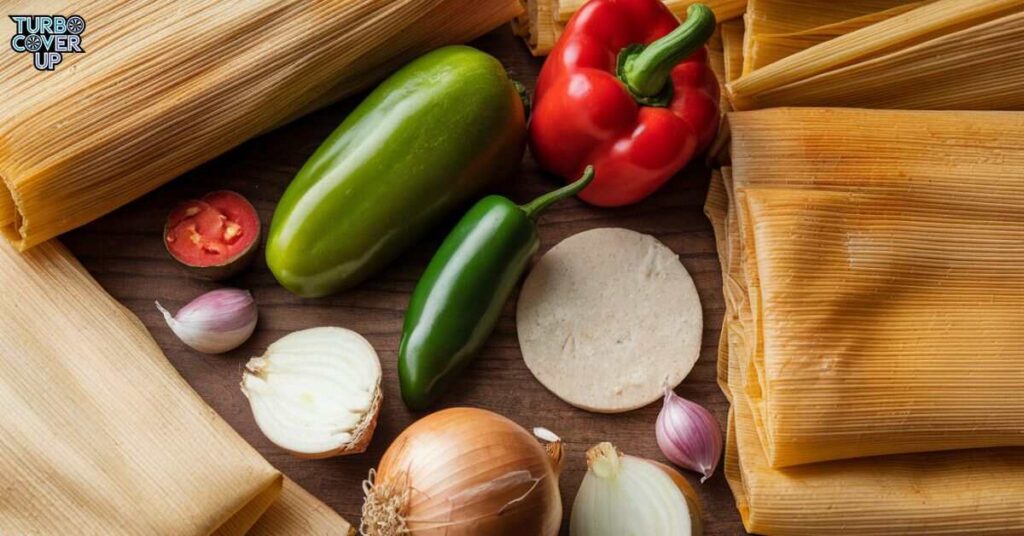Tamales are a delicious staple in many households, often enjoyed during holidays or family gatherings. But what happens when your curious canine decides to snag one off the table?
Can dogs eat tamales? This is a common question dog owners face, especially when their furry friends manage to sneak a bite.
In this comprehensive guide, we’ll discuss the ingredients, and potential risks, and answer all the important questions surrounding dogs and tamales.
Tamale Ingredients
Tamale ingredients are what make these savory treats a concern for dog owners. While tamales may seem harmless, they often contain ingredients that are unsuitable or even dangerous for dogs.
Common Tamale Ingredients

- Meat (pork, chicken, beef): While meat is generally safe for dogs, it’s often cooked with spices, which can be harmful.
- Corn masa: The dough base of tamales, made from corn, isn’t toxic but is difficult for dogs to digest, especially in large quantities.
- Onions and garlic: Common in many tamale recipes, both onions and garlic are toxic to dogs and can cause serious health problems.
- Spices: Tamales are often flavored with chilies and other spices, which can cause stomach upset or more severe digestive issues for dogs.
- Corn husks: While not typically eaten by humans, dogs may chew or swallow the tamale husk, which poses a choking hazard or gastrointestinal blockage.
Tamale Nutrients
Though tamales provide nutritional value for humans, the same can’t be said for dogs. Let’s break down the nutritional content of tamales and examine their impact on your dog’s health.
| Nutrient | Amount per Serving | Dog-Friendly? |
| Calories | ~285 per tamale | Too high for most dogs |
| Protein | 11g | Safe but usually spiced |
| Fat | 15g | Too much fat for dogs |
| Carbohydrates | 25g | Hard to digest for dogs |
| Sodium | 800mg | Dangerous for dogs |
| Fiber | 3g | Not significant for dogs |
While protein from the meat may seem like a healthy option for dogs, the high fat content and spices often mixed in make tamales a poor nutritional choice.
The excess calories and fat could lead to obesity or pancreatitis in dogs, while the sodium can result in salt poisoning, especially if consumed in large amounts.
Is Eating Tamales Safe for Dogs?

The short answer is no. While your dog may not experience immediate harm from a small bite, there are multiple reasons why tamales aren’t safe for dogs. From the tamale ingredients like onions and garlic to the risks posed by the tamale husk, feeding your dog tamales can lead to short- and long-term health problems.
Short-Term Risks
- Stomach upset: Dogs eating tamales often suffer from vomiting or diarrhea due to the tamale spices.
- Salt poisoning: With their high sodium content, tamales can lead to dehydration or worse in dogs.
Long-Term Risks
- Obesity: Frequent consumption of high-calorie tamales can contribute to obesity in dogs.
- Pancreatitis: The high-fat content found in tamales can lead to inflammation of the pancreas, a serious condition that requires medical attention.
Why Are Tamales Not the Most Suitable Food Choice for Dogs?
You might think a small bite of tamale is harmless, but there are several reasons why tamales are a bad idea for dogs. From toxic ingredients to potential choking hazards, let’s explore the dangers.
Onion and Garlic Poisoning
Many tamales are seasoned with onions and garlic, which are toxic to dogs. Both can cause oxidative damage to your dog’s red blood cells, leading to anemia. Even small amounts can be harmful.
Signs of Onion and Garlic Poisoning:
- Vomiting
- Diarrhea
- Lethargy
- Pale gums
- Rapid heart rate
These symptoms may not appear immediately but can lead to serious complications over time. It’s essential to keep dogs and onions as well as dogs and garlic apart to prevent such risks.
Choking and Gastrointestinal Blockage
Another often-overlooked danger is the tamale husk. Although the corn husk is not typically eaten, dogs are curious creatures that might try to chew on it. Ingesting the husk can lead to:
- Choking: The tough texture of the tamale husk can get stuck in your dog’s throat, leading to a choking hazard.
- Blockage: Even if swallowed, the husk is indigestible and can cause a gastrointestinal blockage, which may require surgery.
Dogs and Spices
Tamales often contain a variety of spices, including chili powder, cumin, and paprika. Dogs and spices don’t mix well, as their digestive systems aren’t built to handle hot or spicy foods. Even mild spices can cause discomfort, leading to vomiting, diarrhea, or more severe gastrointestinal issues.
If Your Dog Eats A Tamale By Mistake, What Should You Do?

If your dog eats a tamale by mistake, stay calm and observe them closely. Look for any signs of distress, such as vomiting, diarrhea, or lethargy. These symptoms may indicate that the tamale has caused some digestive issues.
Next, consider what the tamale contained. If it had harmful ingredients like onions or garlic, contact your veterinarian right away. They can provide advice based on your dog’s size, breed, and health history.
Finally, ensure your dog has access to fresh water and monitor their behavior for the next few hours. If they seem fine, keep an eye on them for any changes. If you notice anything unusual, don’t hesitate to reach out to your vet for further guidance.
How Can You Prepare Healthy Tamales For Your Dog?
Preparing healthy tamales for your dog can be a fun and rewarding experience. Here’s how you can create a dog-friendly version of this traditional dish while ensuring it’s safe and nutritious.
Choose Dog-Safe Ingredients
Start with dog-friendly ingredients. Instead of traditional tamale fillings that might include onions, garlic, or spices that can be harmful to dogs, opt for safe choices like lean meats (chicken, turkey, or beef), cooked sweet potatoes, or pumpkin. Avoid any seasonings and stick to plain, unseasoned options. For the masa (dough), use whole wheat flour or corn masa to keep it healthy.
Incorporate Vegetables
Add in some vegetables that are safe for dogs, such as carrots, peas, or green beans. These not only provide added nutrients but also make the tamales more colorful and appealing. Cook the vegetables lightly to make them easier to digest, and mix them in with the protein of your choice.
Cooking Method
To prepare the tamales, wrap the mixture in corn husks or parchment paper instead of using traditional wrappers, which might not be as digestible for dogs. Steam the tamales for about 30-40 minutes until they are fully cooked. Allow them to cool before serving to your dog. Always start with a small portion to see how your dog reacts, and ensure they’re part of a balanced diet.
Frequently Asked Questions
What Happens If My Dog Eats Tamales?
If your dog eats tamales, they may experience mild digestive upset, but ingredients like onions, garlic, and spices can lead to more serious issues. Monitor for symptoms and consult your vet if necessary.
What Are the Possible Issues That Dogs Could Experience After Eating Tamales?
Dogs may face vomiting, diarrhea, or more severe problems like onion/garlic toxicity, pancreatitis, or intestinal blockages.
What Should You Do If Your Dog Eats a Corn Husk?
If your dog swallows a corn husk, monitor for symptoms of blockage such as vomiting or constipation and seek veterinary care if needed.
Can My Dog Consume Canned Tamales?
Canned tamales contain high levels of sodium and preservatives, which can be harmful to dogs and should be avoided.
Final Thoughts
Tamales might seem tempting to share with your dog, but they aren’t a safe or healthy choice. Ingredients like onions, garlic, and spices can cause serious health problems, and even the corn husk can lead to blockages.
If your dog accidentally eats a tamale, keep an eye on them for any unusual symptoms and reach out to your vet if needed. It’s always best to stick to dog-friendly treats that support your dog’s nutrition and health rather than risking it with human foods like tamales.
>>>Read more:

